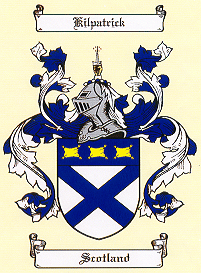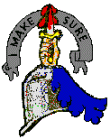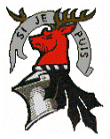Kilpatrick
(How do we fit in to all these Kilpatricks? Go to Kilpatrick Family and find out!)
The Kilpatricks are a sept of Clan Colquhoun of Scotland.
According to the CyberClan Kilpatrick, the name of Colquhoun was taken from the Barony of Colquhoun which lay along the hills to the north of Kilpatrick in Dumbartonshire. At a time in history when "surnames" did not exist, people used a Christian name and were further identified by where they lived or by some personal characteristic, even by their trade.
In the 12th century "Humphrey or Umfridus" lived at Kilpatrick on the banks of the River Clyde. The name Kilpatrick refers to "the church of Patrick", or St. Patrick, the village of Old Kilpatrick being the birthplace of St. Patrick. Humphrey of Kilpatrick was granted the barony of Colquhoun in the 13th century and he became known as Humphrey of Colquhoun.
In the 14th century, Robert de Colquhoun married the daughter of Godfrey, Laird of Luss upon Loch Lomondside, and as she was heiress to the lands of Luss, these passed to her husband, Robert de Colquhoun who became known as Robert Colquhoun of Luss.
Others of the Kilpatrick family who did not move to the Loch Lomond area to live remained around the Clyde in Dumbartonshire and further south, retaining their own surnames.
The Kilpatricks have their own badge and shield, but use the Colquhoun tartans.
The Kilpatrick Coat of Arms is Argent (white) which denotes Peace and Security. The Saltire signifies Perserverance, the Chief signifies Dominion and the three cushions denote Authority.

In 1232 A.D. the Kilpatrick/Kirkpatrick coat-of-arms was authorized by King Alexander II of Scotland. The crest of the coat-of-arms, a hand holding a dagger dripping with blood represents the instrument used by Sir Roger Kilpatrick when he went to the Church of Grey Friars and killed the tyrant Comyn, thus ending his rule and saved Scotland for King Robert the Bruce. The motto on the coat-of- arms, "I Make Sure" or "I Make Sicar" also refers to the same circumstance, meaning that he had made sure that Scotland's arch enemy was dead.
The Kilpatrick badge is

It is, of course, commemorative of Sir Roger's conquest of Comyn. And our motto, "I Make Sure" or "I Make Sicar" is emblazoned on the badge. For something a little less, well, bloody, the Colquhoun badge is this:

The motto, of course, is in French.
There are several buildings and places associated with Kilpatrick, including Closeburn Castle.

To find out about our castles and buildings, click here.
There are several Colquhoun tartans, including the one used for the background of this page, the "modern" tartan. It's faded for the background....the true tartan is this:

Another Colquhoun tartan that emerged in the early 1800s is this:

Sources at the Colquhoun Society of U.K. say that the tartan below:

is the traditional and original Colquhoun tartan.
In recent years, a "dress tartan" has been introduced. It looks like this:

As a sept of Clan Colquhoun, Kilpatricks and Kirkpatricks are entitled to wear the Colquhoun tartan.
That's right, Kirkpatrick, too. According to most authorities it is agreed that the names Kirkpatrick and Kilpatrick are one in the same. "Scots Kith & Kin" says that Kirkpatrick is considered a major sept of the Clan Colquhoun but has affiliation with the Douglas Clan in the 12th century through the "Black Douglasses" of Dumfriesshire. They were also found at Nith in the 12th century.
Like many families and clans in Scotland, the Kirkpatricks most probably took their name from the land or locale in which they originally lived. Though many places no longer exist as villages or homes or geological landmarks, these places were there and usually had a name. "The Surnames of Scotland" says that Kirkpatrick originally came from a chapel dedicated to St. Patrick and gave its' name to the farm in the parish of Closeburn. The prefix Kirk or Kil in Gaelic means a church, thus Kirkpatrick or Kilpatrick translates as Church of Patrick.
The first person of this name found on records was Roger de Kirkpatrick who died in 1141, but no mention is made of his homeland. Ivone de Kirkpatrick had a charter on the whole land of Kelosbern from Alexander II in 1232, which remained in the possession of the family until 1783. A John de Kirkepatrike of Dumfriesshire paid homage to the King in 1296. And Roger de Kirkpatric, a knight, also of Dumfriesshire, swore fealty to England in 1296. The old burial place of the Kirkpatricks of Kirkmuchael is Garrell (the vernacular pronunciation of Garvald).
In Sir Bernard Burkke's Vicissitudes of Families he relates the story of a marriage between a Kirkpatrick and the daughter of the Baron de Grivegnee, and the objections that were raised as to the background of the Kirkpatrick family. "Whereupon Mr. Charles Kirkpatrick Sharpe of Hoddam, was consulted and produced a Kirkpatrick family-tree showing a root in Kings."
"The Surnames of Scotland" by Black also states that the name Kilpatrick was of local origin. Stevene de Kilpatrick del counte de Dunfres rendered homage in 1296. In the 15th and 18th centuries there was an area in the parish of Closeburn, Dumfriesshire named Kilpatrick. Many people derived their names from East or West Kilpatrick in Dumbartonshire. Thus when Humphrey of Kilpatrick became the chief of Clan Colquhoun he assumed the name Colquhoun as did his descendants. Colquhoun is in the parish of old Kilpatrick. The family of Kilpatricks had taken their name from the country around them. Today in the present area known as Dumbarton there is a Loch Humphrey in the Kilpatrick Hills, between Milngavie and Dunbarton.

Scottish Lineage Index
Kilpatrick Family
Kilpatrick Ancestral Lands

This site created and maintained by Juli Risener Morgan
© 2003 by Juli Risener Morgan









